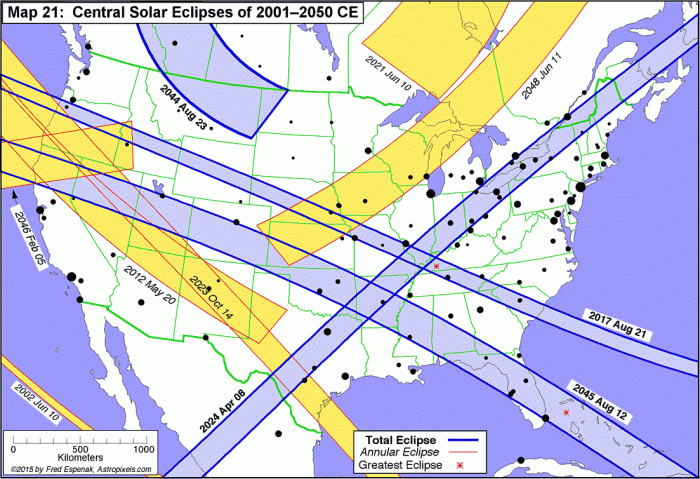Frequently Asked Questions (FAQs): When Is The Next Total Solar Eclipse In The World After 2025

Total solar eclipses are awe-inspiring celestial events, but understanding the science behind them and ensuring safe viewing practices is crucial. This section addresses common questions regarding these remarkable occurrences.
Causes of a Total Solar Eclipse
A total solar eclipse happens when the Moon passes directly between the Sun and the Earth, completely blocking the Sun’s light from reaching a small area on Earth’s surface. This alignment, known as syzygy, is only possible because the apparent sizes of the Sun and Moon in the sky are nearly identical, a purely coincidental phenomenon. The Moon’s shadow, cast upon the Earth, has two main parts: the umbra, a region of complete shadow where a total eclipse is visible, and the penumbra, a region of partial shadow where a partial eclipse is visible. The precise geometry of the Sun, Moon, and Earth dictates the path of totality, the narrow band across the Earth’s surface where the total eclipse can be observed. Slight variations in the Moon’s orbit mean that the umbra doesn’t always reach the Earth’s surface, resulting in annular eclipses where a ring of sunlight is visible around the Moon.
Frequency of Total Solar Eclipses
Total solar eclipses are relatively rare events at any given location on Earth. While a solar eclipse of some kind (partial, annular, or total) occurs somewhere on Earth about every six months, total solar eclipses are less frequent. On average, a total solar eclipse is visible from a particular location on Earth only once every 375 years. However, the path of totality moves across the Earth’s surface, so different locations will experience a total eclipse at different times. The predictability of these events is quite high, with astronomers able to calculate the date, time, and path of totality for eclipses many years in advance, using precise models of celestial mechanics.
Sources for Certified Solar Eclipse Glasses
Safe viewing of a solar eclipse is paramount. Never look directly at the Sun without proper eye protection. Certified solar eclipse glasses are essential for protecting your eyes from the Sun’s intense radiation. These glasses must meet the ISO 12312-2 international safety standard. Reliable sources for certified glasses include reputable astronomy clubs, science museums, and online retailers that explicitly state compliance with the ISO standard. Avoid glasses that do not clearly indicate this certification, as they may not offer adequate protection. It’s crucial to inspect your glasses before use, ensuring they are free of scratches or damage.
Risks Associated with Viewing a Solar Eclipse, When Is The Next Total Solar Eclipse In The World After 2025
Looking directly at the Sun during a solar eclipse, even for a short period, can cause serious and permanent eye damage, including solar retinopathy. This damage can lead to blurred vision, blind spots, and even complete vision loss. The Sun’s intense light can burn the retina, the light-sensitive tissue at the back of the eye. Even during a total eclipse, when the Sun is completely obscured by the Moon, it is unsafe to look directly at the Sun without proper eye protection. The brief moments before and after totality still emit harmful radiation. Other risks associated with eclipse viewing can include crowds, traffic congestion, and exposure to the elements, depending on the viewing location and weather conditions.
When Is The Next Total Solar Eclipse In The World After 2025 – Determining when the next total solar eclipse will occur globally after 2025 requires consulting astronomical data. However, a significant event closer to hand is the Total Solar Eclipse of 2025, visible in parts of the United States, including Ohio; you can find more information about this at Total Solar Eclipse 2025 Ohio. Following the 2025 eclipse, future total solar eclipses will be spread across various locations worldwide, their precise timing dependent upon celestial mechanics.
Planning to witness a total solar eclipse? The next one after 2025 is still a few years away, but first, we have the upcoming spectacle on April 8th. You can learn more about this significant event by visiting this informative site: The 2025 Solar Eclipse Will Be Total And Will Take Place On April 8. Afterward, be sure to mark your calendars for future celestial events!
Planning to witness a total solar eclipse? While many are eagerly anticipating the 2025 event, you might be wondering when the next one occurs. To understand the timing of future eclipses, it’s helpful to first look at the specifics of the upcoming one; you can find precise details on the timing of the Total Solar Eclipse in 2025 by checking this site: Total Solar Eclipse 2025 Time.
After gaining a clearer picture of the 2025 eclipse, researching subsequent total solar eclipses will be much easier.
Planning your next eclipse viewing? While the spectacular 2024 event is behind us, many are already looking ahead. To understand where to be for the next big one, it’s helpful to first examine the path of totality for the 2025 eclipse, detailed here: Total Solar Eclipse 2025 Path Of Totality. This will give you a better idea of what to expect and help you plan for future total solar eclipses after 2025.
Planning your next eclipse viewing? While pinpointing the exact date for the total solar eclipse after 2025 requires further astronomical calculations, understanding past paths is key. To better prepare, reviewing the specifics of the 2025 event, such as the Total Solar Eclipse Path 2025 , provides valuable insight into future eclipse prediction and viewing opportunities. This helps us anticipate where and when to expect the next celestial spectacle.